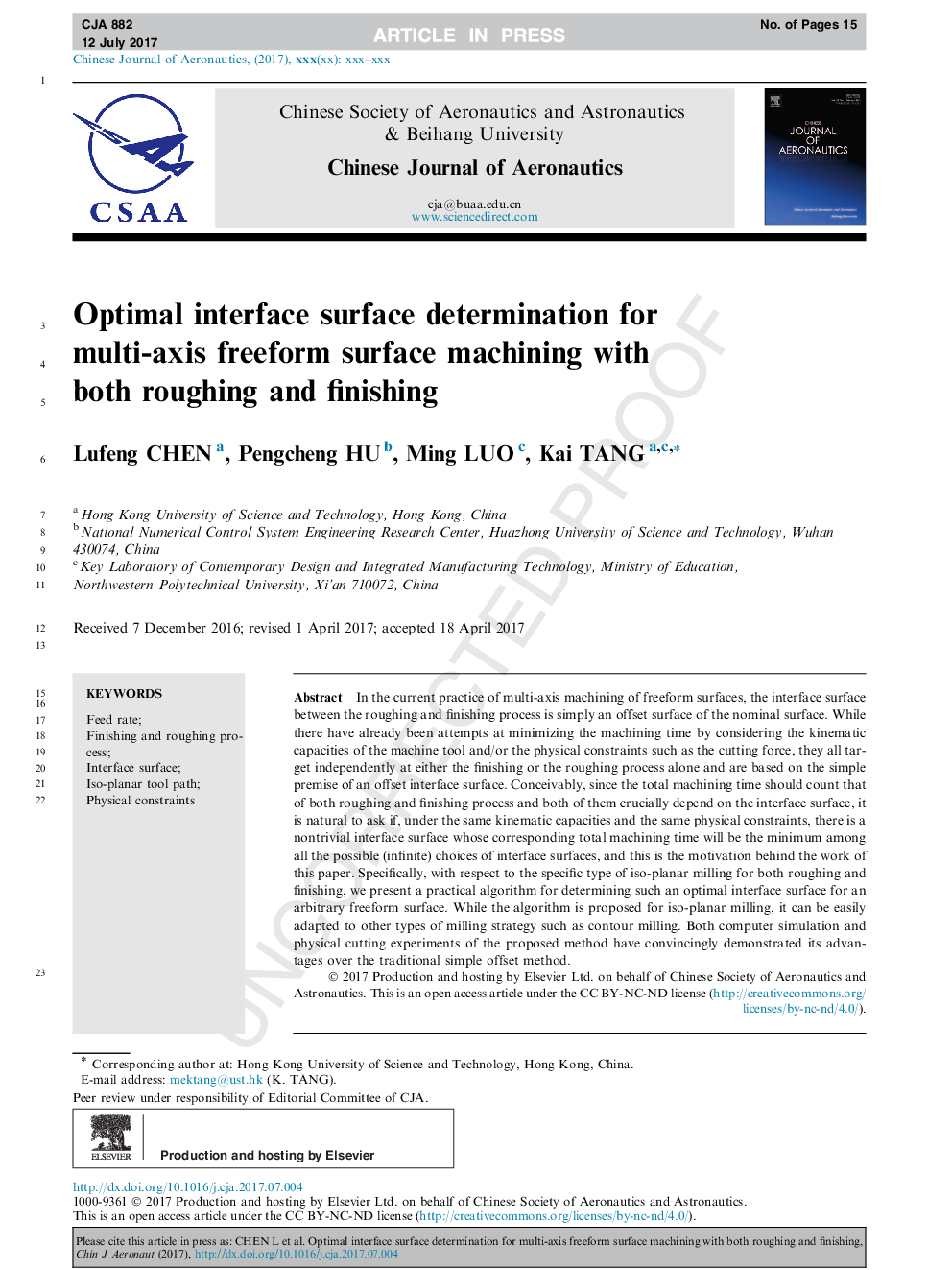| کد مقاله | کد نشریه | سال انتشار | مقاله انگلیسی | نسخه تمام متن |
|---|---|---|---|---|
| 7153797 | 1462490 | 2018 | 15 صفحه PDF | دانلود رایگان |
عنوان انگلیسی مقاله ISI
Optimal interface surface determination for multi-axis freeform surface machining with both roughing and finishing
ترجمه فارسی عنوان
تعیین سطح رابط بهینه برای ماشینکاری سطحی آزاد در قالب چند محور با هر دو زنگ زدن و اتمام
دانلود مقاله + سفارش ترجمه
دانلود مقاله ISI انگلیسی
رایگان برای ایرانیان
کلمات کلیدی
نرخ خوراک، فرایند تکمیل و روهینگ، سطح رابط مسیر ابزار ایزو فلاری، محدودیت های فیزیکی،
ترجمه چکیده
در عمل فعلی ماشینکاری چند محور از سطوح آزاد، سطح رابط بین فرایند روانکاری و اتمام به سادگی یک سطح افست سطح اسمی است. در حالی که تلاش هایی برای به حداقل رساندن زمان ماشینکاری با توجه به ظرفیت های سینماتیکی دستگاه و / یا محدودیت های فیزیکی مانند نیروی برش انجام شده است، همه آنها به طور مستقل در هر دو مرحله تکمیل یا فرآیند روهینگ به طور جداگانه هدف قرار می گیرند و بر اساس فرض ساده ی یک سطح رابط افست. احتمالا از آنجا که کل زمان ماشینکاری باید هر دو فرآیند روجینگ و اتمام را در نظر بگیرد و هر دو آنها به طور جدی به سطح رابط متصل شوند، طبیعی است که بپرسید که اگر تحت همان ظرفیت های سینماتیکی و همان محدودیت های فیزیکی یک رابط کاربری غیر رسمی وجود داشته باشد سطح که زمان ماشینکاری کامل مربوط به آن حداقل در میان تمام گزینه های ممکن (بی نهایت) سطوح رابط است، و این انگیزه در پشت کار این مقاله است. به طور خاص، با توجه به نوع خاصی از فرزکاری ایزو-پلاناری برای هر دو سرخ کردن و تکمیل، ما یک الگوریتم عملی برای تعیین چنین سطح رابط مناسب برای یک سطح آزمایشی دلخواه ارائه می دهیم. در حالی که الگوریتم برای تراشکاری ایزو فلاری پیشنهاد شده است، می توان آن را به راحتی به سایر انواع استراتژی های فرزکاری مانند تراورس کنتور متصل کرد. هر دو شبیه سازی کامپیوتری و آزمایش های فیزیکی برش از روش پیشنهادی به طور قانع کننده مزایای خود را نسبت به روش افست ساده سنتی نشان می دهد.
موضوعات مرتبط
مهندسی و علوم پایه
سایر رشته های مهندسی
مهندسی هوافضا
چکیده انگلیسی
In the current practice of multi-axis machining of freeform surfaces, the interface surface between the roughing and finishing process is simply an offset surface of the nominal surface. While there have already been attempts at minimizing the machining time by considering the kinematic capacities of the machine tool and/or the physical constraints such as the cutting force, they all target independently at either the finishing or the roughing process alone and are based on the simple premise of an offset interface surface. Conceivably, since the total machining time should count that of both roughing and finishing process and both of them crucially depend on the interface surface, it is natural to ask if, under the same kinematic capacities and the same physical constraints, there is a nontrivial interface surface whose corresponding total machining time will be the minimum among all the possible (infinite) choices of interface surfaces, and this is the motivation behind the work of this paper. Specifically, with respect to the specific type of iso-planar milling for both roughing and finishing, we present a practical algorithm for determining such an optimal interface surface for an arbitrary freeform surface. While the algorithm is proposed for iso-planar milling, it can be easily adapted to other types of milling strategy such as contour milling. Both computer simulation and physical cutting experiments of the proposed method have convincingly demonstrated its advantages over the traditional simple offset method.
ناشر
Database: Elsevier - ScienceDirect (ساینس دایرکت)
Journal: Chinese Journal of Aeronautics - Volume 31, Issue 2, February 2018, Pages 370-384
Journal: Chinese Journal of Aeronautics - Volume 31, Issue 2, February 2018, Pages 370-384
نویسندگان
Lufeng CHEN, Pengcheng HU, Ming LUO, Kai TANG,
